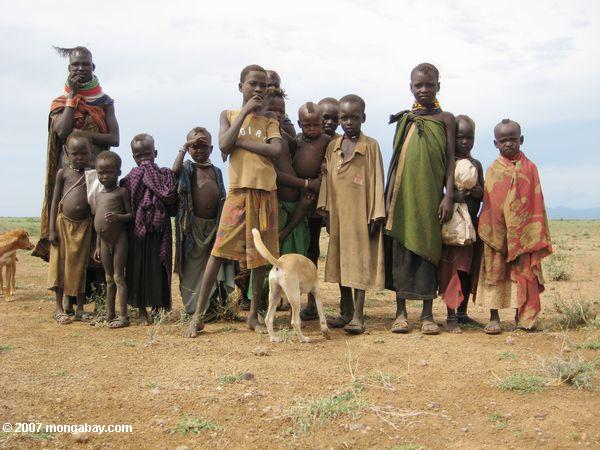
The Turkana people fear their ecosystem will be gravely impacted by the Gibe III dam on the Omo River. Photo by: Rhett A. Butler.
Originally refusing to provide funding to Ethiopia’s controversial Gibe III hydroelectric dam, the World Bank has now announced plans to fund the power lines that will carry generated electricity away from it. In their official statement they report that the lines will “connect Ethiopia’s electrical grid with Kenya’s, create power-sharing between the two countries, reduce energy costs, promote sustainable and renewable power generation [and] better protect the region’s environment…eventually benefiting 212 million people in five countries.” Skeptics argue that this is only the most recent in a long string of World Bank funded projects, which promote economic growth at the cost of the environment and of indigenous peoples and their ways of life.
Underway since 2006, the building of the Gibe III dam on the Omo River in Ethiopia has polarized the opinions of both experts and those who stand to be affected. Proponents of the dam claim that its construction poses minimal risk to the environment and to the livelihoods of hundreds of thousands of people downstream. However, their assessment depends on the consistent application of a proposed system of artificial flooding to replace the natural seasonal cycles on which the indigenous tribes of the Omo River Delta currently depend. Those who oppose the dam, including an independent panel of scientists from around the world, naming themselves the African Resources Working Group (ARWG), warn against flaws and falsifications in the official impact assessments, including that the management plans of at least five past sub-Saharan dam projects have included proposals for artificial flooding but failed to implement them.
Also at risk, according to critics, are the rich riparian forests of the Omo River Valley and the survival of the world’s largest desert lake, Lake Turkana, which both depend on the flow of the Omo River, and which are in turn depended upon by the indigenous tribes that live around them. Official assessments downplay the impact of the Gibe III dam on the water-level of Lake Turkana as limited to the three year period in which the dam’s reservoir fills, after which artificial flow management will eliminate the problems associated with abnormally dry years and protect the valley against damaging floods such as those that occurred in 2006.
The ARWG argues, however, that the official assessment fails to figure reservoir leakage due to fissures in the basalt surrounding the site, which raises the estimate of water loss in Lake Turkana to as high as 10 meters. This could result in a salinity increase substantial enough to render the lake unusable as drinking water and toxic to the fish and other aquatic animals that live in it. The ARWG also argues that the 2006 floods in the Omo Valley represent an event so rare that it does not justify official claims that the dam would actually help protect the environment downstream.
According to the ARWG, the fundamental problem with the Ethiopian EPA assessments is that they were carried out only after the second year of the dam’s construction and funded by the Ethiopian Electric Power Corporation, which stands to gain the most from the project’s completion. From the perspective of the World Bank however, its decision to fund the power lines is one step removed from the ethical questions surrounding the dam itself, to which they have, so far, lent no capital. “Contrary to claims, the World Bank is not financing the Gibe III dam in Ethiopia,” the bank reports in its online factsheet for the project, going on to say that the dam will be built and generating electricity long before the World Bank-funded power line project comes to fruition. Against claims that Gibe III will affect Indigenous Peoples in Ethiopia, the World Bank statement narrows the focus, reporting that their field reviews show that “there are no Indigenous Peoples in areas traversed by the Bank-financed interconnector,” but it declines to address the problems presented by the dam to which these power lines will be linked. To the people of the Omo River Valley and the ARWG the distinction is a superficial one.
The Gibe III debate is likely to continue until its true impacts are revealed by the dam’s completion, and at its heart is a question becoming ever-more important to our world: what is progress?
Related articles
Tiger and cubs filmed near proposed dam in Thailand
(09/04/2012) A tigress and two cubs have been filmed by remote camera trap in a forest under threat by a $400 million dam in Thailand. To be built on the Mae Wong River, the dam imperils two Thai protected areas, Mae Wong National Park and Huay Kha Khaeng Wildlife Sanctuary, according to the World Wide Fund for Nature (WWF)
Brazil’s controversial Belo Monte back on track after court decision overruled
(08/29/2012) Brazil’s Supreme Court on Tuesday ordered work on the controversial Belo Monte dam in the Amazon to resume, overturning a lower court order that suspended the project less than two weeks ago. Construction activities by the Norte Energia, the consortium building the dam, resumed immediately, according to the Associated Press.
Mekong dam spree could create regional food crisis

(08/27/2012) Fish are a hugely important protein source for many people around the world. This is no more evident than along the lower Mekong River delta where an estimated 48 million people depend directly on the river for food and livelihoods. But now a new study in Global Environmental Change cautions that 11 planned hydroelectric dams in the region could cut vital fish populations by 16 percent while putting more strain on water and land resources.